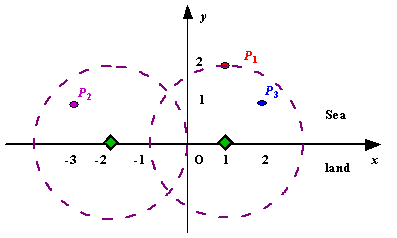Description
Assume the coasting is an infinite straight line. Land is in one side of coasting, sea in the other. Each small island is a point locating in the sea side. And any radar installation, locating on the coasting, can only cover d distance, so an island in the
sea can be covered by a radius installation, if the distance between them is at most d.
We use Cartesian coordinate system, defining the coasting is the x-axis. The sea side is above x-axis, and the land side below. Given the position of each island in the sea, and given the distance of the coverage of the radar installation, your task is to write a program to find the minimal number of radar installations to cover all the islands. Note that the position of an island is represented by its x-y coordinates.

Figure A Sample Input of Radar Installations
We use Cartesian coordinate system, defining the coasting is the x-axis. The sea side is above x-axis, and the land side below. Given the position of each island in the sea, and given the distance of the coverage of the radar installation, your task is to write a program to find the minimal number of radar installations to cover all the islands. Note that the position of an island is represented by its x-y coordinates.

Figure A Sample Input of Radar Installations
Input
The input consists of several test cases. The first line of each case contains two integers n (1<=n<=1000) and d, where n is the number of islands in the sea and d is the distance of coverage of the radar installation. This is followed by n lines each containing
two integers representing the coordinate of the position of each island. Then a blank line follows to separate the cases.
The input is terminated by a line containing pair of zeros
The input is terminated by a line containing pair of zeros
Output
For each test case output one line consisting of the test case number followed by the minimal number of radar installations needed. "-1" installation means no solution for that case.
Sample Input
3 2 1 2 -3 1 2 1 1 2 0 2 0 0
Sample Output
Case 1: 2Case 2: 1
#include <cmath> #include <iostream> #include <cstdio> #include <cstring> #include <cstdlib> #include <vector> #include <algorithm> using namespace std; struct Space{ double l, r; Space(double l = 0, double r = 0):l(l),r(r){} bool operator < (const Space & rhs) const { return r < rhs.r; } }; Space a[1024]; int main() { ios::sync_with_stdio(false); int n, kase = 0, ok = 1; double d; while(memset(a, 0, sizeof(a)), ok = 1, cin >> n >> d && (n || d)){ for(int i = 0; i < n; ++i){ double x, y; cin >> x >> y; if(y > d){ok = 0; continue;} double r = sqrt(d*d - y*y); a[i] = Space(x - r, x + r); } if(!ok){printf("Case %d: %d ", ++kase, -1); continue;} sort(a, a + n); double End = a[0].r; int cnt = 1; for(int i = 1; i < n; ++i){ if(a[i].l > End ){ ++cnt; End = a[i].r; } } printf("Case %d: %d ", ++kase, cnt); } return 0; }